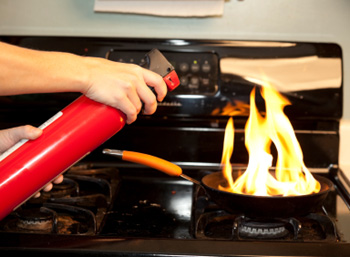Fire Extinguisher : 101
Kitchen Class K Fires: How to Fight Them
| Home |
| About Fire Extinguishers |
| Using a Fire Extinguisher |
| Fire Prevention |
| Fire Hazards |
| First Aid for Fire |
| Financial Protection |
| Biggest Fires in History |
| Firefighters |
This site was voted:

by onlinefiresciencedegree.org
(scroll to 74 on the list)
This page provides information about class K fires. |
In order to effectively fight a fire you need to know how it was started and what is making it burn. Often the fuel is important and dictates how the flames should be fought. Class K fires burn a specific type of fuel, namely cooking fat and oils, and can spread quickly, causing damage and potential injury.
Class K flames are technically a subclass of class B flames, since it involves flammable liquid. However, because of some unique characteristics related to this type of fire, it was designated separately and requires a distinct battling method.
 What
Types of Cooking Substances Are Dangerous?
What
Types of Cooking Substances Are Dangerous?
Heat is important when cooking, and oils and fats are often used
to create that heat as they can be brought to a high temperature quickly.
These highly flammable substances are used to fry and sauté foods,
and when they catch fire, they must be brought under control immediately.
Some examples of cooking oils and fats include:
- Vegetable oils like canola, corn, and safflower
- Olive oil
- Butter
- Margarine
- Lard
- Bacon grease
Class K fires are most often caused by cooking oils and fat that burst into flame on the stovetop, in the oven or on the grill. There is also a risk of causing such a fire when these substances are overheated in the microwave.
Fighting
Class K Fires
Since this class of fire burns hotter than typical class B fires,
the extinguishing methods used for B flames will not work on K flames.
Some of the fire extinguishers rated for use with this type of cooking
fire have a hood, which serves to cut off the oxygen and smother the flames.
Splashes of extremely hot cooking oil or fat can cause serious burns, even life-threatening injuries. Anyone attempting to put out the class K flames on their own should be well aware of the dangers. A firefighter must approach such a fire fully protected.
Firefighting
Equipment
Saponification is the quickest and most effective way to fight
class K fires. Fire extinguishers rated for use with class K dangers always
contain a wet chemical extinguishing agent which turns the cooking oil
and fat that is serving as fuel to soap. The substance is non-combustible
and actually absorbs the heat from the flames, eliminating or reducing
that element necessary for a fire to continue to burn. These extinguishers
are often equipped with a physical component resembling a hood, which
can be placed directly over the flames – if they are small enough
– cutting off the oxygen and stifling the fire.
Protecting
your Home or Business against Class K Fires
Industrial and commercial buildings that are equipped with kitchens
need to be well-equipped against the dangers of class K fires. Businesses
such as restaurants and cafeterias must follow the local building codes
when designing and equipping their kitchens, and ensure that all staff
members are fully trained in how to properly respond to a fire of any
class.
In a residential setting, class K fires usually start in the kitchen, and can spread to cause major damage and injury. Having a properly rated fire extinguisher is important, and every member of the household should know the effective response to this type of fire.